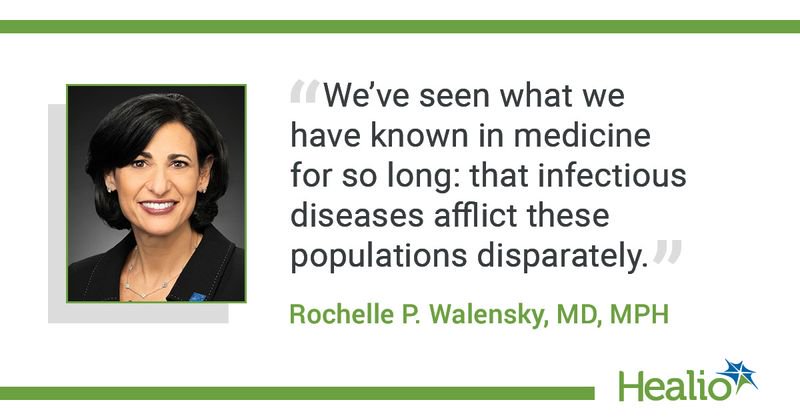CDC director: Disparities in COVID-19 are ‘striking’
After 15 months on the job, CDC Director Rochelle P. Walensky, MD, MPH, said that one of the most important lessons she has learned is the need for a better understanding of health care inequities in the United States.
Walensky, who made the comments during the virtual ACP Internal Medicine Meeting, also emphasized the importance of “following the science” to inform policy decisions, like safely reopening schools.

Impact of COVID-19 on Black, Hispanic populations
According to Walensky, COVID-19 has drawn even greater attention to the numerous challenges facing underrepresented populations.
“We've seen what we have known in medicine for so long: that infectious diseases afflict these populations disparately,” she said.
Walensky cited a study that showed that 18.7% of COVID-19 deaths were reported in Black individuals, who comprise only 12.5% of the total U.S. population. Another study reported that overall life expectancy in the U.S. dropped 1 year during the first 6 months of 2020, and the impact was even greater in the Hispanic and Black communities, with life expectancy dropping 1.9 and 2.7 years, respectively.
Some of the data have been “quite striking,” Walensky said. She added that health disparities extend to vaccination efforts. Recent data show that only 9% of Hispanics in the U.S. have been fully vaccinated, for example.
“We are working hard to make inroads in ensuring that there's [vaccine] access in all areas,” she said. “We still have a lot more work to do.”
‘Following the science’
Walensky used the CDC’s evolving guidance for schools to illustrate that the agency is following a science-driven approach to prevent transmission of COVID-19.
She said early data indicated that school closures led to a significant decline in COVID-19 transmission, suggesting the schools did the right thing when they closed soon after the public health emergency was declared. Over time, the CDC studied COVID-19 transmission, giving them the data to create the original “blueprint” to reopen schools safely, Walensky said.
However, it became clear that it would be difficult for school students, teachers and others in the educational field to maintain a distance of 6 feet, she said. Most recently, two studies determined that a distance of 3 feet was safe, even in areas with high incidence of COVID-19, so long as universal masking and other COVID-19 protocols were in place.
“With these pieces of data, we then updated our K to 12 guidance” to where it is now, Walensky said.
Accelerated vaccine development
Normally, a vaccine can take up to 15 years to develop, but amid the pandemic, three vaccines were available in less than 1 year.
“The reason we were able to condense it is because we were able to stand on the shoulders of a lot of preclinical trial work that had been done on mRNA vaccines,” she said. “We were able to layer our phase one, two and three trials on top of each other.”
Walensky also recalled how the FDA and the Advisory Committee on Immunization Practices accelerated their usual procedures, allowing quicker vaccine distribution.
All these efforts combined showed how hard work benefits public health, she said.
‘We need to bolster our workforce’
Walensky said that retaining an adequate public health workforce was a challenge before the pandemic — a situation made worse by COVID-19.
“We’ve been flat-funded for 10 years,” she said. “To improve our outcomes in this pandemic and future threats, we need to bolster our workforce.”
According to Walensky, the CDC offers several programs to strengthen the health care workforce, including training programs in public health, laboratory work and epidemic services.
Reference:
Gold JA, et al. MMWR. Morb Mortal Wkly Rep. 2020;doi:10.15585/mmwr.mm6942e1.
Correction: The article was updated with the correct percentage of deaths caused COVID-19 among Black individuals. Healio Primary Care regrets the error.

